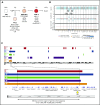Familial predisposition to TP53/complex karyotype MDS and leukemia in DNA repair-deficient xeroderma pigmentosum
- PMID: 30914417
- PMCID: PMC6610036
- DOI: 10.1182/blood-2019-01-895698
Familial predisposition to TP53/complex karyotype MDS and leukemia in DNA repair-deficient xeroderma pigmentosum
Abstract
There is a
Conflict of interest statement
Conflict-of-interest disclosure: The authors declare no competing financial interests.
Figures

Comment in
-
FouNdER mutations confer risk for leukemias.Blood. 2019 Jun 20;133(25):2636-2638. doi: 10.1182/blood-2019-04-901173. Blood. 2019. PMID: 31221794 No abstract available.
References
-
- Kraemer KH, Sarasin A. Xeroderma pigmentosum. In: Elder DE, Massi D, Scolyer RA, Willemze R, eds. WHO Classification of Skin Tumours, 4th ed Lyon, France: IARC Press; 2018:386-387.
-
- Hanawalt PC, Spivak G. Transcription-coupled DNA repair: two decades of progress and surprises. Nat Rev Mol Cell Biol. 2008;9(12):958-970. - PubMed
-
- Soufir N, Ged C, Bourillon A, et al. . A prevalent mutation with founder effect in xeroderma pigmentosum group C from north Africa. J Invest Dermatol. 2010;130(6):1537-1542. - PubMed
-
- Desandes E, Lacour B, Belot A, et al. . Cancer incidence and survival in adolescents and young adults in France, 2000-2008. Pediatr Hematol Oncol. 2013;30(4):291-306. - PubMed
Publication types
MeSH terms
Substances
Supplementary concepts
LinkOut - more resources
Full Text Sources
Medical
Research Materials
Miscellaneous

